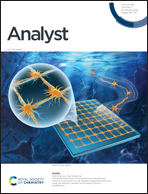Serratia marcescens-derived fluorescent carbon dots as a platform toward multi-mode bioimaging and detection of p-nitrophenol†
Abstract
Carbon dots (CDs) have excellent application prospects in various fields such as fluorescent dyes, but expanding their application, especially in bioimaging and the detection of organic pollutants, is still a major research objective. In this study, fluorescent CDs were successfully synthesized via the hydrothermal method using Serratia marcescens KMR-3. The platform based on CDs-KMR3 exhibited excellent stability, good biocompatibility, and low biotoxicity, and can be effectively applied to the imaging of bacteria, fungi, plant cells, protozoa and mammalian cells, and can specifically stain the membranes of all tested cells. In this study, for the first time, bacteria-derived CDs were used to image the representative species of organisms ranging from lower-order to higher-order organisms, thereby proving the feasibility of the application of CDs in the fluorescence imaging of Paramecium caudatum. Additionally, CDs-KMR3 can rapidly diffuse into all the parts of the leaf through diffusion into the veins and intercellular interstitium in response to the induction of transpiration. Moreover, the data illustrate that CDs-KMR3 are likely to enter the digestive tracts of microworms by ingestion through the oral cavity and pharynx, and spread to the pseudocoelom and somatic cells, and finally to be excreted from microworms through the anus. Furthermore, this platform can be utilized as fluorescent probes for the rapid and highly selective detection of p-nitrophenol (p-NP). Moreover, this study contributed to the increased application of bacteria-derived CDs in bioimaging and detection of p-NP.



 Please wait while we load your content...
Please wait while we load your content...